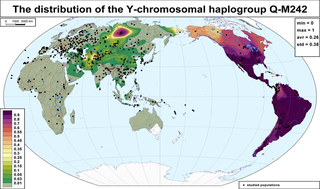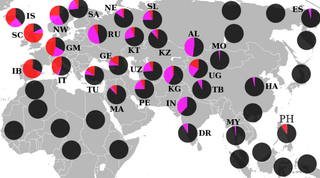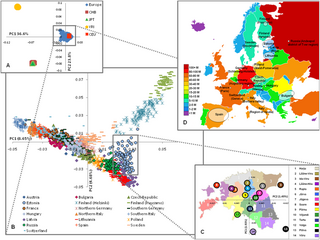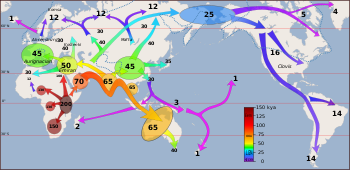
The Book of Mormon is a religious text of the Latter Day Saint movement, first published in 1830 by Joseph Smith as The Book of Mormon: An Account Written by the Hand of Mormon upon Plates Taken from the Plates of Nephi.

The Lamanites are one of the four peoples described as having settled in the ancient Americas in the Book of Mormon, a sacred text of the Latter Day Saint movement. The Lamanites also play a role in the prophecies and revelations of the Doctrine and Covenants, another sacred text in the Latter Day Saint movement.

The relationship between Archaeology and the Book of Mormon is based on the claims made by the Book of Mormon that could be verified or discredited by archeological investigations. While members of the Church of Jesus Christ of Latter-day Saints and other denominations of the Latter Day Saint movement believe the Book of Mormon describes ancient historical events in the Americas, the available historical and archaeological facts point to the book being an anachronistic invention of Joseph Smith. Since the book's publication in 1830, Mormon archaeologists have been trying to use archaeological evidence to confirm the veracity of the narratives, but this has proved unsuccessful.
Genetic genealogy is the use of genealogical DNA tests, i.e., DNA profiling and DNA testing, in combination with traditional genealogical methods, to infer genetic relationships between individuals. This application of genetics came to be used by family historians in the 21st century, as DNA tests became affordable. The tests have been promoted by amateur groups, such as surname study groups or regional genealogical groups, as well as research projects such as the Genographic Project.
Thomas W. Murphy is an American anthropologist and writer. His work has focused on environmental issues and various topics related to The Church of Jesus Christ of Latter-day Saints.
Haplogroup K or K-M9 is a genetic lineage within human Y-chromosome DNA haplogroup. A sublineage of haplogroup IJK, K-M9, and its descendant clades represent a geographically widespread and diverse haplogroup. The lineages have long been found among males on every continent except Antarctica.
Haplogroup P also known as P-F5850 or K2b2 is a Y-chromosome DNA haplogroup in human genetics. P-F5850 is a branch of K2b, which is a branch of Haplogroup K2 (K-M526).

Haplogroup Q or Q-M242 is a Y-chromosome DNA haplogroup. It has one primary subclade, Haplogroup Q1 (L232/S432), which includes numerous subclades that have been sampled and identified in males among modern populations.
Haplogroup Q-M3 (Y-DNA) is a Y-chromosome DNA haplogroup. Haplogroup Q-M3 is a subclade of Haplogroup Q-L54. Haplogroup Q-M3 was previously known as Haplogroup Q3; currently Q-M3 is Q1b1a1a below Q1b-M346.

Haplogroup R1, or R-M173, is a Y-chromosome DNA haplogroup. A primary subclade of Haplogroup R (R-M207), it is defined by the SNP M173. The other primary subclade of Haplogroup R is Haplogroup R2 (R-M479).
Haplogroup R, or R-M207, is a Y-chromosome DNA haplogroup. It is both numerous and widespread amongst modern populations.

Tungusic peoples are an ethnolinguistic group formed by the speakers of Tungusic languages. They are native to Siberia, China, and Mongolia.

The genetic history of Europe includes information around the formation, ethnogenesis, and other DNA-specific information about populations indigenous, or living in Europe.

In human mitochondrial genetics, Haplogroup Y is a human mitochondrial DNA (mtDNA) haplogroup.
In human mitochondrial genetics, Haplogroup G is a human mitochondrial DNA (mtDNA) haplogroup.

The historicity of the Book of Mormon is the historical actuality of persons and events that are written in it, meaning the quality of it being part of history instead of being a historical myth, legend, or fiction. Many members of the Latter Day Saint movement believe that the Book of Mormon is historically accurate. Most, but not all, Latter Day Saints hold the book's connection to ancient American history as an article of their faith. This view finds no confirmation outside of the movement in the broader scientific and academic communities. Relevant archaeological, historical, and scientific facts are not consistent with the Book of Mormon being an ancient record of actual historical events.
Simon G. Southerton is an Australian plant geneticist and co-founder of Gondwana Genomics, an Australian technology firm specialising in Marker-assisted selection for tree breeding. Southerton published the book Losing a Lost Tribe: Native Americans, DNA, and the Mormon Church. The book uses genetic evidence to examine the historical accuracy of the Book of Mormon and related claims about the Lamanite people.
The genetic history of the Indigenous peoples of the Americas is divided into two distinct periods: the initial peopling of the Americas during about 20,000 to 14,000 years ago, and European contact, after about 500 years ago. The first period of the genetic history of Indigenous Americans is the determinant factor for the number of genetic lineages, zygosity mutations, and founding haplotypes present in today's Indigenous American populations.
Haplogroup K2b (P331), also known as MPS is a human y-chromosome haplogroup that is thought to be less than 3,000 years younger than K, and less than 10,000 years younger than F, meaning it probably is around 50,000 years old, according to the age estimates of Tatiana Karafet et al. 2014.
This article summarizes the genetic makeup and population history of East Asian peoples and their connection to genetically related populations, as well as Oceanians and partly, Central Asians and South Asians, which are collectively referred to as "East Eurasians" in population genomics.








